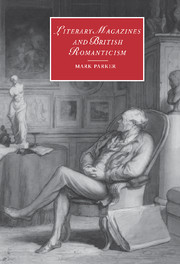Book contents
- Frontmatter
- Contents
- Acknowledgments
- Introduction: the study of literary magazines
- Chapter 1 Ideology and editing: the political context of the Elia essays
- Chapter 2 A conversation between friends: Hazlitt and the London Magazine
- Chapter 3 The burial of Romanticism: the first twenty installments of “Noctes Ambrosianae”
- Chapter 4 Magazine Romanticism: the New Monthly 1821–1825
- Chapter 5 Sartor Resartus in Fraser's toward a dialectical politics
- Conclusion
- Notes
- Bibliography
- Index
- Cambridge Studies in Romanticism
Chapter 3 - The burial of Romanticism: the first twenty installments of “Noctes Ambrosianae”
Published online by Cambridge University Press: 22 September 2009
- Frontmatter
- Contents
- Acknowledgments
- Introduction: the study of literary magazines
- Chapter 1 Ideology and editing: the political context of the Elia essays
- Chapter 2 A conversation between friends: Hazlitt and the London Magazine
- Chapter 3 The burial of Romanticism: the first twenty installments of “Noctes Ambrosianae”
- Chapter 4 Magazine Romanticism: the New Monthly 1821–1825
- Chapter 5 Sartor Resartus in Fraser's toward a dialectical politics
- Conclusion
- Notes
- Bibliography
- Index
- Cambridge Studies in Romanticism
Summary
There are many extraordinary achievements in literary magazines between 1820 and 1825: Lamb's Elia essays, Hazlitt's Table-Talk, De Quincey's “Confessions of an English Opium Eater,” and Landor's “Imaginary Conversations.” But while one might argue that the magazine provides the space and opportunity for the talents of each writer, and that specific features of literary magazines (personality, periodicity, commodification) inform each of these conspicuous successes, it is only in the “Noctes Ambrosianae” of Blackwood's Magazine that writers begin fully and consciously to exploit the particular resources of the literary magazine. “Noctes Ambrosianae,” at least in its first twenty installments, internalizes the dialogism implicit in the form of the literary magazine in order to carry out a searching analysis of its effects. It persistently blurs the line between literature and criticism, and in doing so it calls into question the very critical authority it asserts. Finally, by inviting the reader to consider the complications attendant upon figural uses of language, it encourages a particularly knowing kind of reader, one sensitive to the fictionality as well as the fiction of the literary magazine.
To explore these aspects of “Noctes Ambrosianae” it is necessary to shift our interpretive procedures from the abstractions of the class-based reading of Blackwood's employed earlier to an account of the collaborative efforts of a small group of highly individual writers.
- Type
- Chapter
- Information
- Literary Magazines and British Romanticism , pp. 106 - 134Publisher: Cambridge University PressPrint publication year: 2001

